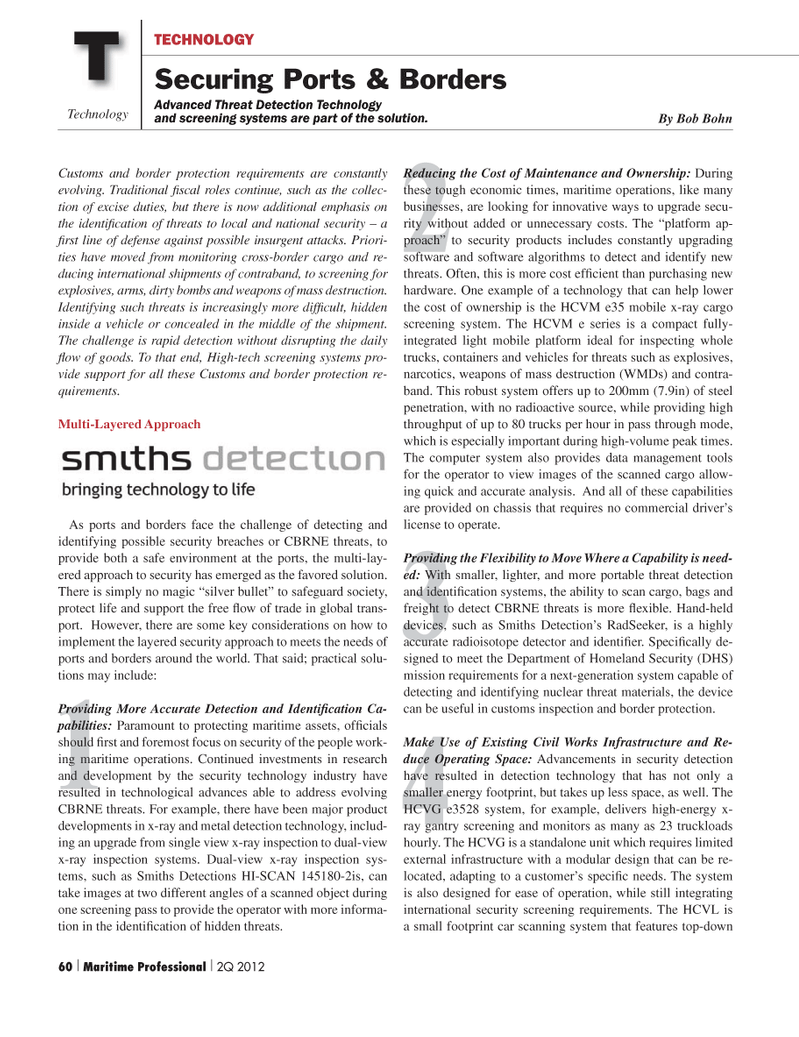
Page 60: of Maritime Logistics Professional Magazine (Q2 2012)
Maritime Risk
Read this page in Pdf, Flash or Html5 edition of Q2 2012 Maritime Logistics Professional Magazine
4 2 1 3
Customs and border protection requirements are constantly evolving. Traditional fi scal roles continue, such as the collec- tion of excise duties, but there is now additional emphasis on the identifi cation of threats to local and national security – a fi rst line of defense against possible insurgent attacks. Priori- ties have moved from monitoring cross-border cargo and re- ducing international shipments of contraband, to screening for explosives, arms, dirty bombs and weapons of mass destruction.
Identifying such threats is increasingly more diffi cult, hidden inside a vehicle or concealed in the middle of the shipment.
The challenge is rapid detection without disrupting the daily fl ow of goods. To that end, High-tech screening systems pro- vide support for all these Customs and border protection re- quirements.
Multi-Layered Approach
As ports and borders face the challenge of detecting and identifying possible security breaches or CBRNE threats, to provide both a safe environment at the ports, the multi-lay- ered approach to security has emerged as the favored solution.
There is simply no magic “silver bullet” to safeguard society, protect life and support the free fl ow of trade in global trans- port. However, there are some key considerations on how to implement the layered security approach to meets the needs of ports and borders around the world. That said; practical solu- tions may include:
Providing More Accurate Detection and Identifi cation Ca- pabilities: Paramount to protecting maritime assets, offi cials should fi rst and foremost focus on security of the people work- ing maritime operations. Continued investments in research and development by the security technology industry have resulted in technological advances able to address evolving
CBRNE threats. For example, there have been major product developments in x-ray and metal detection technology, includ- ing an upgrade from single view x-ray inspection to dual-view x-ray inspection systems. Dual-view x-ray inspection sys- tems, such as Smiths Detections HI-SCAN 145180-2is, can take images at two different angles of a scanned object during one screening pass to provide the operator with more informa- tion in the identifi cation of hidden threats.
Reducing the Cost of Maintenance and Ownership: During these tough economic times, maritime operations, like many businesses, are looking for innovative ways to upgrade secu- rity without added or unnecessary costs. The “platform ap- proach” to security products includes constantly upgrading software and software algorithms to detect and identify new threats. Often, this is more cost effi cient than purchasing new hardware. One example of a technology that can help lower the cost of ownership is the HCVM e35 mobile x-ray cargo screening system. The HCVM e series is a compact fully- integrated light mobile platform ideal for inspecting whole trucks, containers and vehicles for threats such as explosives, narcotics, weapons of mass destruction (WMDs) and contra- band. This robust system offers up to 200mm (7.9in) of steel penetration, with no radioactive source, while providing high throughput of up to 80 trucks per hour in pass through mode, which is especially important during high-volume peak times.
The computer system also provides data management tools for the operator to view images of the scanned cargo allow- ing quick and accurate analysis. And all of these capabilities are provided on chassis that requires no commercial driver’s license to operate.
Providing the Flexibility to Move Where a Capability is need- ed: With smaller, lighter, and more portable threat detection and identifi cation systems, the ability to scan cargo, bags and freight to detect CBRNE threats is more fl exible. Hand-held devices, such as Smiths Detection’s RadSeeker, is a highly accurate radioisotope detector and identifi er. Specifi cally de- signed to meet the Department of Homeland Security (DHS) mission requirements for a next-generation system capable of detecting and identifying nuclear threat materials, the device can be useful in customs inspection and border protection.
Make Use of Existing Civil Works Infrastructure and Re- duce Operating Space: Advancements in security detection have resulted in detection technology that has not only a smaller energy footprint, but takes up less space, as well. The
HCVG e3528 system, for example, delivers high-energy x- ray gantry screening and monitors as many as 23 truckloads hourly. The HCVG is a standalone unit which requires limited external infrastructure with a modular design that can be re- located, adapting to a customer’s specifi c needs. The system is also designed for ease of operation, while still integrating international security screening requirements. The HCVL is a small footprint car scanning system that features top-down
Technology
TECHNOLOGY
Securing Ports & Borders
Advanced Threat Detection Technology and screening systems are part of the solution.
T
By Bob Bohn 60 | Maritime Professional | 2Q 2012
MP #2 50-64 NEW STYLES.indd 60 5/4/2012 6:33:55 PM

 59
59

 61
61
